八年级下英语第二单元第一课时教案
人教版八下英语Unit2全单元教案
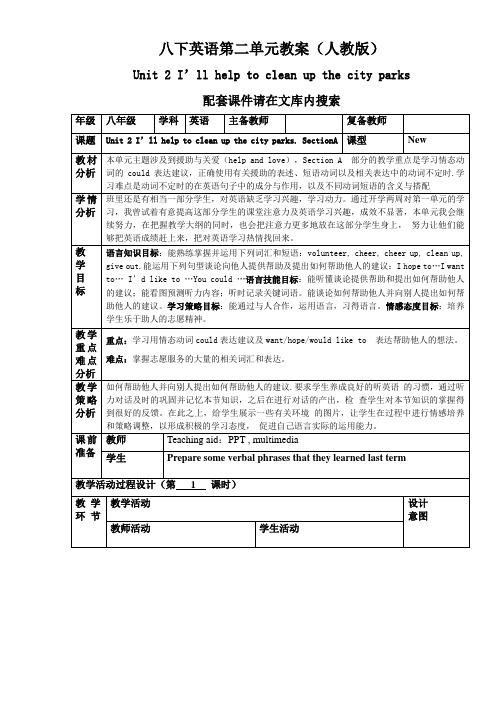
1.This weekend the Association of Susong Volunteer is going to have a volunteering activity. Here are the four activities.And each group of you will take part in one of the activities. But what could
学情分析
班里还是有相当一部分学生,对英语缺乏学习兴趣,学习动力。通过开学两周对第一单元的学习,我曾试着有意提高这部分学生的课堂注意力及英语学习兴趣,成效不显著,本单元我会继续努力,在把握教学大纲的同时,也会把注意力更多地放在这部分学生身上, 努力让他们能够把英语成绩赶上来,把对英语学习热情找回来。
教
学
目
标
语言知识目标:能熟练掌握并运用下列词汇和短语:volunteer, cheer, cheer up, clean up, give out.能运用下列句型谈论向他人提供帮助及提出如何帮助他人的建议:I hope to…I want to… I’d like to …You could …语言技能目标:能听懂谈论提供帮助和提出如何帮助他人的建议;能看图预测听力内容;听时记录关键词语。能谈论如何帮助他人并向别人提出如何帮助他人的建议。学习策略目标:能通过与人合作,运用语言,习得语言。情感态度目标:培养学生乐于助人的志愿精神。
Greet the teacher.
Get ready for the new lesson
ห้องสมุดไป่ตู้教学
环节
教学活动
设计
意图
To arouse Ss’ imagination and help them love their hometown better.
人教版八年级英语下册第二单元教案[001]
![人教版八年级英语下册第二单元教案[001]](https://img.taocdn.com/s3/m/4cbe66370a4c2e3f5727a5e9856a561252d321f2.png)
Unit 2 I’ll help to clean up the city parks. 教材解读本单元的核心话题为“volunteering”,围绕着主动提供帮助,以观察图片、听力理解、阅读理解等训练方式和独立学习、合作交流、完成任务等形式完成目标语言的输入,学习“I’d like…”“You could...”等句型和一些重要动词短语为主要学习内容,并且设置任务型综合性语言实践活动,让学生在交际活动中,学会如何正确地用英语表达自己的意见和建议,重在培养学生的习得语言运用能力、实践能力、合作能力及创新意识,通过本单元的学习,使学生能向别人提供帮助,争做一名志愿者。
单元目标一、知识及技能1. 掌握重点单词和短语:clean up,cheer up,give out,put off,set up,think up,take after,fix up,give away,put up,hand out,work out,at once2. 掌握情态动词could,should的用法;用should或could提出建议并对别人的建议作出评价。
3. 掌握重点句型:(1) I’d like to / I want to / I decide to…(2) You could…(3) We should…二、过程及方法交际法:学外语的主要目的不是在掌握语言结构本身,而是在发展学生的交际能力,让他们在创设的交际情景中学会知识,以便能再运用于现实交际活动中。
情境创设法:创设情境为学生营造感受英语,说英语的氛围。
三、情感态度及价值观在授课过程中渗透助人就是助己、助人收获快乐的情感目标,使学生在谈论如何为别人提供帮助的对话中能意识到尽己所能帮助他人、乐于奉献是一种良好的品德,培养学生为他人着想、热爱公益事业、乐于助人的优良品质。
教法导航新课程的背景下,要求学生以“任务”为前提,进行有条件、有目的的听、说、读、写活动。
【精选】人教版八年级下册英语Unit2(第二单元)优秀教案
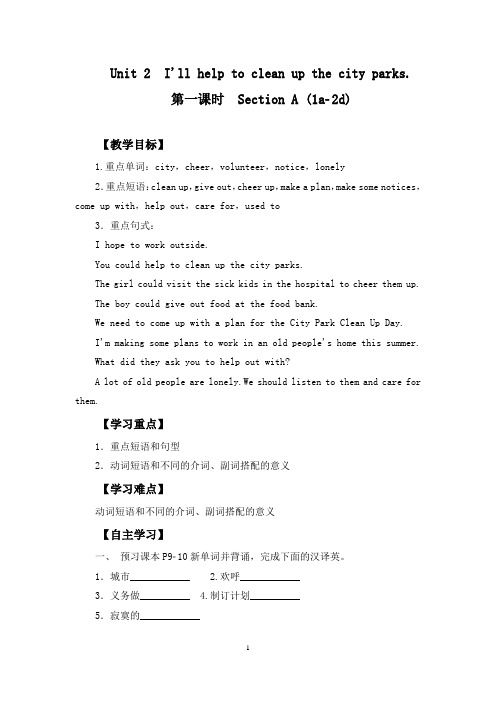
Unit 2 I'll help to clean up the city parks.第一课时Section A (1a2d)【教学目标】1.重点单词:city,cheer,volunteer,notice,lonely2.重点短语:clean up,give out,cheer up,make a plan,make some notices,come up with,help out,care for,used to3.重点句式:I hope to work outside.You could help to clean up the city parks.The girl could visit the sick kids in the hospital to cheer them up.The boy could give out food at the food bank.We need to come up with a plan for the City Park Clean Up Day.I'm making some plans to work in an old people's home this summer.What did they ask you to help out with?A lot of old people are lonely.We should listen to them and care for them.【学习重点】1.重点短语和句型2.动词短语和不同的介词、副词搭配的意义【学习难点】动词短语和不同的介词、副词搭配的意义【自主学习】一、预习课本P910新单词并背诵,完成下面的汉译英。
1.城市____________ 2.欢呼____________3.义务做__________ 4.制订计划__________5.寂寞的____________二、认真预习1a2d找出下列短语和句型。
八年级第二单元英语下册教师上课教案Unit 2 第1课时教案(八下)
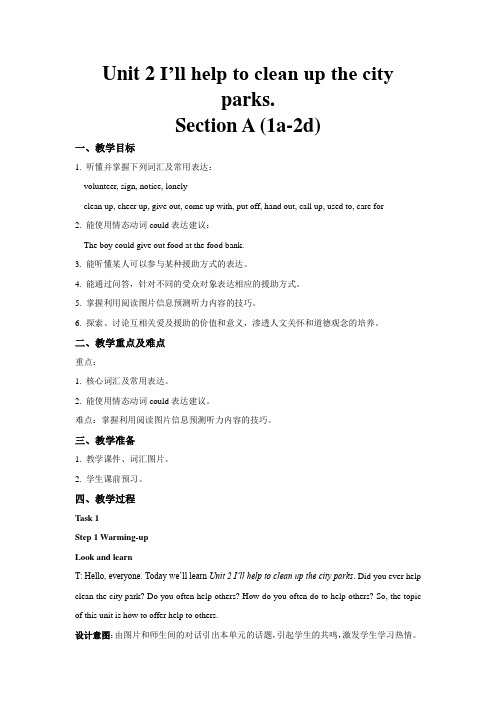
Unit 2 I’ll help to clean up the cityparks.Section A (1a-2d)一、教学目标1. 听懂并掌握下列词汇及常用表达:volunteer, sign, notice, lonelyclean up, cheer up, give out, come up with, put off, hand out, call up, used to, care for2. 能使用情态动词could表达建议:The boy could give out food at the food bank.3. 能听懂某人可以参与某种援助方式的表达。
4. 能通过问答,针对不同的受众对象表达相应的援助方式。
5. 掌握利用阅读图片信息预测听力内容的技巧。
6. 探索、讨论互相关爱及援助的价值和意义,渗透人文关怀和道德观念的培养。
二、教学重点及难点重点:1. 核心词汇及常用表达。
2. 能使用情态动词could表达建议。
难点:掌握利用阅读图片信息预测听力内容的技巧。
三、教学准备1. 教学课件、词汇图片。
2. 学生课前预习。
四、教学过程Task 1Step 1 Warming-upLook and learnT: Hello, everyone. Today we’ll learn Unit 2 I’ll help to clean up the city parks. Did you ever help clean the city park? Do you often help others? How do you often do to help others? So, the topic of this unit is how to offer help to others.设计意图:由图片和师生间的对话引出本单元的话题,引起学生的共鸣,激发学生学习热情。
Watch and thinkT: As a student, what can you do to offer help? There’re also some organizations offering help to people i n need in our country or in the world. Let’s watch a short video. You can think about what the video discusses while watching.设计意图:吸引学生注意力,进一步渗透单元话题。
2018人教版初中英语八年级下册Unit2单元教学设计
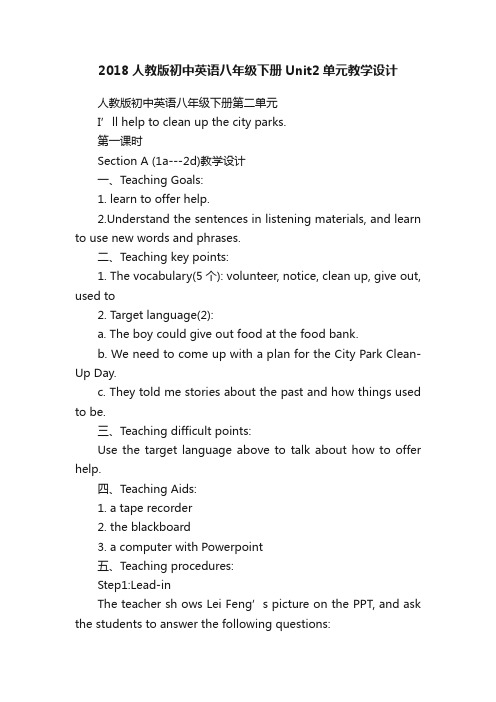
2018人教版初中英语八年级下册Unit2单元教学设计人教版初中英语八年级下册第二单元I’ll help to clean up the city parks.第一课时Section A (1a---2d)教学设计一、Teaching Goals:1. learn to offer help.2.Understand the sentences in listening materials, and learn to use new words and phrases.二、Teaching key points:1. The vocabulary(5个): volunteer, notice, clean up, give out, used to2. Target language(2):a. The boy could give out food at the food bank.b. We need to come up with a plan for the City Park Clean-Up Day.c. They told me stories about the past and how things used to be.三、Teaching difficult points:Use the target language above to talk about how to offer help.四、Teaching Aids:1. a tape recorder2. the blackboard3. a computer with Powerpoint五、Teaching procedures:Step1:Lead-inThe teacher sh ows Lei Feng’s picture on the PPT, and ask the students to answer the following questions:Who is this man? Why is he so famous in China?(the answer will be mostly like this: he is famous because he always helps others.)Step2: Asking-and-answering activities with the target language(Show pictures on the PPT about volunteering work.)Step3: PairworkNow, the teacher asks the Ss to think about what they can do to help others.S1: I can read to the old.S2: I can help my parents to clean up the living room.S3: …Step4: listening1page 9, 1b.play the tape and ask the students to listen and number the ways the boy and the girl could help others.page9,1cPractice the conversation in the picture above. Then make other conversations using the information in 1b. Then give Ss five minutes to make conversations.(two Ss a pair)Step 5: Listening 2page10,2a,2b1.listento yhe tape and check the things they are going to do to tellpeople about it.2.listen again, and fiil in the blanks.a.We need to _______ _______ _______a plan to tell people about the citypark clean-up.b.Clean up day is only two weeks from now. We can’t________ _______making a plan.c.We could ________ _______ signs.d.Let’s make some notices, too. Then I’ll _______ them_______ a fterschool.e.We could each _______ _______ 10 students and ask them to come. Step 6: Roleplay the conversation.(1)help oneself to sth.随便吃食物等。
2020年春人教新目标英语八年级下册Unit2-全单元教案
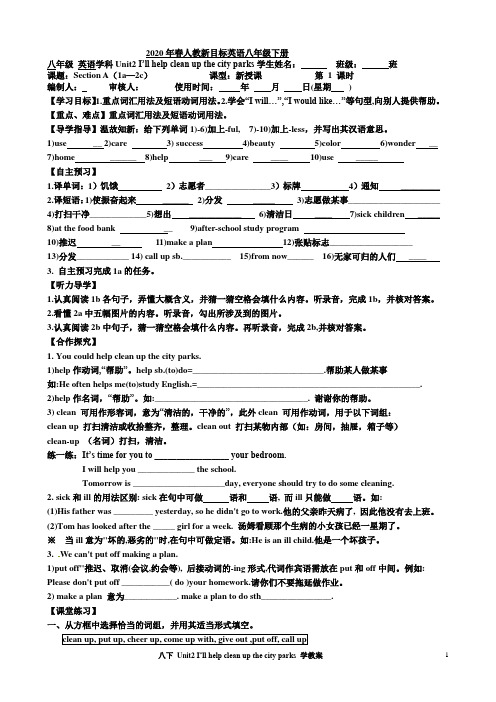
2020年春人教新目标英语八年级下册八年级英语学科Unit2 I’ll help clean up the city parks学生姓名:班级:班课题:Section A(1a—2c)课型:新授课第1 课时编制人:审核人:使用时间:年月日(星期)【学习目标】1.重点词汇用法及短语动词用法。
2.学会“I will…”,“I would like…”等句型,向别人提供帮助。
【重点、难点】重点词汇用法及短语动词用法。
【导学指导】温故知新:给下列单词1)-6)加上-ful, 7)-10)加上-less,并写出其汉语意思。
1)use __ 2)care 3) success 4)beauty 5)color 6)wonder __ 7)home ______ 8)help ___ 9)care ____ 10)use _____【自主预习】1.译单词:1)饥饿2)志愿者_______________3)标牌4)通知_________2.译短语:1)使振奋起来______ 2)分发_____ 3)志愿做某事_____________________ 4)打扫干净_____________5)想出____________ 6)清洁日____ 7)sick children _____ 8)at the food bank __ 9)after-school study program10)推迟__ 11)make a plan 12)张贴标志___________________13)分发____________ 14) call up sb.___________ 15)from now______ 16)无家可归的人们____ 3. 自主预习完成1a的任务。
【听力导学】1.认真阅读1b各句子,弄懂大概含义,并猜一猜空格会填什么内容。
听录音,完成1b,并核对答案。
2.看懂2a中五幅图片的内容。
听录音,勾出所涉及到的图片。
2020年春人教新目标英语八年级下册Unit2全单元教案(无答案)
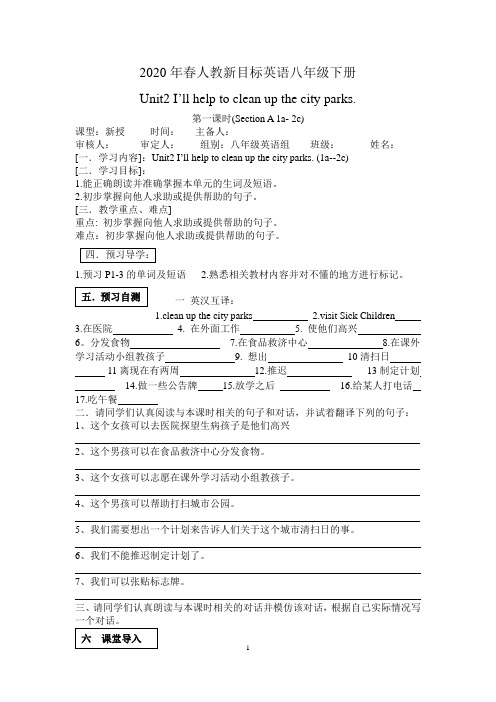
2020年春人教新目标英语八年级下册Unit2 I’ll help to clean up the city parks.第一课时(Section A 1a- 2c)课型:新授时间:主备人:审核人:审定人:组别:八年级英语组班级:姓名:[一.学习内容]:Unit2 I’ll help to clean up the city parks. (1a--2c)[二.学习目标]:1.能正确朗读并准确掌握本单元的生词及短语。
2.初步掌握向他人求助或提供帮助的句子。
[三.教学重点、难点]重点: 初步掌握向他人求助或提供帮助的句子。
难点:初步掌握向他人求助或提供帮助的句子。
1.预习P1-3的单词及短语2.熟悉相关教材内容并对不懂的地方进行标记。
一英汉互译:1.clean up the city parks2.visit Sick Children3.在医院4. 在外面工作5. 使他们高兴6。
分发食物7.在食品救济中心_____8.在课外学习活动小组教孩子9. 想出10清扫日______ 11离现在有两周_____12.推迟13制定计划__ ____ 14.做一些公告牌15.放学之后16.给某人打电话17.吃午餐二.请同学们认真阅读与本课时相关的句子和对话,并试着翻译下列的句子:1、这个女孩可以去医院探望生病孩子是他们高兴2、这个男孩可以在食品救济中心分发食物。
3、这个女孩可以志愿在课外学习活动小组教孩子。
4、这个男孩可以帮助打扫城市公园。
5、我们需要想出一个计划来告诉人们关于这个城市清扫日的事。
6、我们不能推迟制定计划了。
7、我们可以张贴标志牌。
三、请同学们认真朗读与本课时相关的对话并模仿该对话,根据自己实际情况写一个对话。
让学生小组回忆以前所学的有关于委婉(一)教学步骤1. 解读学习目标,学习新词汇2.教师通过玩游戏”Touch your ---”,然后引出询问向他人求助或提供帮助的句子:A: I like reading books.What could you do? B:You could volunteerin an after-school study program to teach kids. (选出写的好的小组进行加分)并核查预习案3.给学生5分钟的时间,让他们模仿1a中的短语进行相互问答练习并把他们编的对话写下来,听听力完成1 b,然后进行相互问答练习。
八年级英语下册Unit2 Section A教案人教版
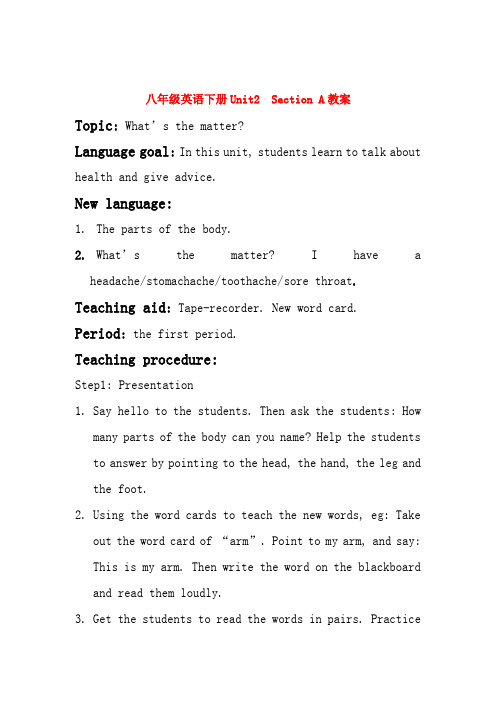
八年级英语下册Unit2 Section A教案Topic: What’s the matter?Language goal: In this unit, students learn to talk about health and give advice.New language:1.The parts of the body.2. What’s the matter? I have aheadache/stomachache/toothache/sore throat. Teaching aid: Tape-recorder. New word card.Period: the first period.Teaching procedure:Step1: Presentation1.Say hello to the students. Then ask the students: Howmany parts of the body can you name? Help the students to answer by pointing to the head, the hand, the leg and the foot.ing the word cards to teach the new words, eg: Takeout the word card of “arm”. Point to my arm, and say: This is my arm. Then write the word on the blackboard and read them loudly.3.Get the students to read the words in pairs. Practicethe words like this:S1: (Point to his head) What’s this?S2: It’s your head. Where’s your ear?S1: It’s here. (Point to the ear)Step 2: 1a1.Ask students to look at the pictures of the studentsnumbered 1 through 5. Several body parts are marked with the letters a-m. Write the correct letter after the name of each body part on the list.2.Point out the sample answer “k”before the word“arm”.3.Ask students to complete the activity individually.4.Check the answers.e the word cards to consolidate the new words. Ask thestudents to read the words and point to the part of the body.Step3: Learn the illness.1.Act out an illness. For example:Hold the head and say: I have a headache. Get the students to repeat and explain the meaning of the word and sentence.2.Point to one of the people in the picture and ask:What’s the matter? Then answer: He has a stomachache.Get the students repeat. Then ask the other people and learn the illness such as: have a cold, have a toothache, have a sore throat, etc.Step4: 1b1.Ask the students to look and read the names in 1b.2.Say, you will hear 5 conversations. Look at the pictureand find the people that are being talked about. Write the number next to their name here.3.Play the recording twice and find the correct answers. Step5: 1c Pairwork.1.Point out the sample conversation in the box. Ask twostudents to read it to the class.2.Say, now work with a partner. Make your ownconversations about the pictures.3.As they talk, move around the room and monitoring theirwork.4.Ask several students to present their dialogues. Homework:write the new words.附:教案特色自我评价这是八年级英语下册第二单元《 What’s the matter 》Section A第一课时的一篇教案。
新人教版八年级英语下册Unit2(1)教案
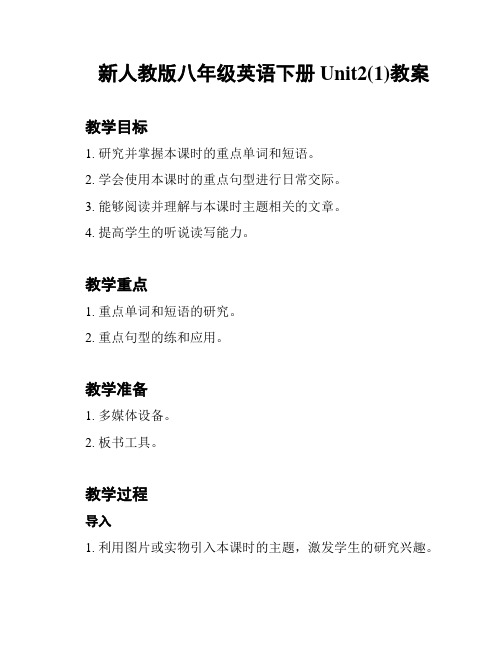
新人教版八年级英语下册Unit2(1)教案
教学目标
1. 研究并掌握本课时的重点单词和短语。
2. 学会使用本课时的重点句型进行日常交际。
3. 能够阅读并理解与本课时主题相关的文章。
4. 提高学生的听说读写能力。
教学重点
1. 重点单词和短语的研究。
2. 重点句型的练和应用。
教学准备
1. 多媒体设备。
2. 板书工具。
教学过程
导入
1. 利用图片或实物引入本课时的主题,激发学生的研究兴趣。
基础知识研究
1. 分组教学:教师通过多媒体展示本课时的重点单词和短语,
并进行发音和拼写的练。
学生根据教师的指导进行跟读和模仿。
语言运用
1. 集体合作:教师以问答形式引导学生运用本课时的重点句型
进行对话练,加深对句型的理解和掌握。
阅读理解
1. 小组活动:将学生分成小组,给每个小组发放相关阅读材料,让学生进行阅读并回答相关问题。
听力训练
1. 教师播放本课时相关的听力材料,学生仔细听后,回答相关
问题。
拓展延伸
1. 学生根据所学句型和词汇,编写一个关于本课时主题的简短
对话,并与同伴进行表演。
总结反思
1. 教师对本节课进行总结,提醒学生本课时的研究重点和难点。
作业布置
1. 布置相应的作业,例如完成课后题,或写一篇关于本课时主
题的短文。
板书设计
使用多媒体展示相应单词、短语和句型,并根据教学内容进行
板书。
人教版英语八年级下册Unit2SectionA1a2d教学设计
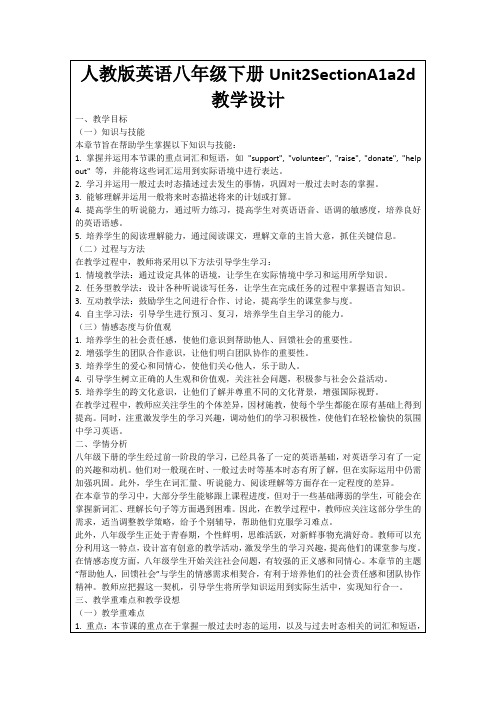
4.鼓励学生互相交流、讨论作业,共同提高。
2.邀请学生分享他们对这些图片的理解和感受,从而引出本节课的主题:“帮助他人,回馈社会”。
3.教师提出问题:“Can you tell me what you did to help others in the past?”,让学生运用一般过去时态分享自己的经历,为新课的学习做好铺垫。
(二)讲授新知
2.学习并运用一般过去时态描述过去发生的事情,巩固对一般过去时态的掌握。
3.能够理解并运用一般将来时态描述将来的计划或打算。
4.提高学生的听说能力,通过听力练习,提高学生对英语语音、语调的敏感度,培养良好的英语语感。
5.培养学生的阅读理解能力,通过阅读课文,理解文章的主旨大意,抓住关键信息。
(二)过程与方法
(三)情感态度与价值观
1.培养学生的社会责任感,使他们意识到帮助他人、回馈社会的重要性。
2.增强学生的团队合作意识,让他们明白团队协作的重要性。
3.培养学生的爱心和同情心,使他们关心他人,乐于助人。
4.引导学生树立正确的人生观和价值观,关注社会问题,积极参与社会公益活动。
5.培养学生的跨文化意识,让他们了解并尊重不同的文化背景,增强国际视野。
b. How did you feel about it?
c. What are you planning to do to help others in the future?
2.各小组进行讨论,并记录下讨论成果,准备进行课堂展示。
(四)课堂练习
1.教师设计以下练习题,帮助学生巩固所学知识:
a.填空题:根据句意,用适当的时态和词汇完成句子。
人教英语八年级下册-Unit 2 Section A(1a-2d) 教案设计
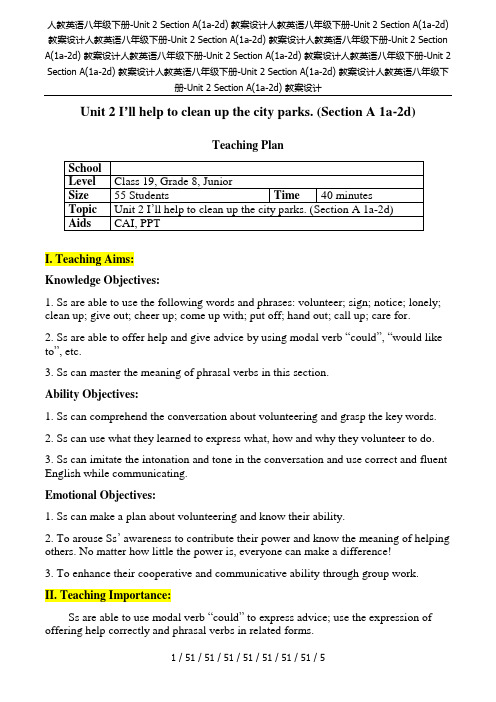
册-Unit 2 Section A(1a-2d) 教案设计Unit 2 I’ll help to clean up the city parks. (Section A 1a-2d)Teaching PlanI. Teaching Aims:Knowledge Objectives:1. Ss are able to use the following words and phrases: volunteer; sign; notice; lonely; clean up; give out; cheer up; come up with; put off; hand out; call up; care for.2. Ss are able to offer help and give advice by using modal verb “could”, “would like to”, etc.3. Ss can master the meaning of phrasal verbs in this section.Ability Objectives:1. Ss can comprehend the conversation about volunteering and grasp the key words.2. Ss can use what they learned to express what, how and why they volunteer to do.3. Ss can imitate the intonation and tone in the conversation and use correct and fluent English while communicating.Emotional Objectives:1. Ss can make a plan about volunteering and know their ability.2. To arouse Ss’ awareness to contribute their power and know the meaning of helping others. No matter how little the power is, everyone can make a difference!3. To enhance their cooperative and communicative ability through group work.II. Teaching Importance:Ss are able to use modal verb “could” to express advice; use the expression of offering help correctly and phrasal verbs in related forms.册-Unit 2 Section A(1a-2d) 教案设计III. Teaching Difficulties:To learn well the meaning and collocation of phrasal verbs.IV. Teaching Aids:Multi-media computer; PPTV. Teaching Methods:Communicative Approach; Task-based Approach; Situational ApproachVI. Blackboard Design:VII. Procedures and Time Allotment:Step I Lead-in (2mins)Show Ss some picture about themselves to introduce the phrases such as “hand out new books”; “clean up classroom”; “help with each other”. And then show them a class photo about volunteer activity then have done.Step II General Idea of Volunteer (3mins)册-Unit 2 Section A(1a-2d) 教案设计Introduce the logo of Chinese young volunteers and the volunteer organization in our school.Introduce phrases “go outside school”“clean up”“give out pens”“read books to children”“cheer them up” in a story with music.Step III Listening 1b (5mins)1. Pre-listeningLook at the picture in 1a and talk about what are they talking about.2. While listeningListen and number the ways the boy and the girl could help others.Listen and match verbs and nouns and then make a sentence3. Post-listeningUnderline the places(where did they do the volunteer jobs) and check the answers. Make a conversation with Ss and use the sentence structures: I hope…; I want to…; I’d like to…; I need to…; I decided to…; Let’s do….Step IV Listening 2b (5mins)1. Pre-listeningQuestion: How to tell more people about volunteer?Show Ss some pictures about the ways to call up more people and use the phrases: put up signs; call up friends and hand out notices.2. While listening册-Unit 2 Section A(1a-2d) 教案设计Listen and fill in the blanks in 2b.3. Post-listeningCheck the answer in groups and translate the key words.Step V Volunteer in the world (2mins)Show Ss some pictures in life and in the world and type of volunteer:Transportation volunteer; Olympic volunteer; APEC volunteer;Guide volunteer; Animal volunteerAnd let them know the happiness of helping others.Step VI Wechat Information 2d (3mins)Listen and read the Wechat and answer the two questions:1. What can we do for old people?2. Why do old people need help?Step VII Conversation 2d (5mins)1. Read the conversation in 2d and fill the blanks.We need to work in __________ home. We could ______ the newspaper to the old people or just ______ to them. They would tell me _____about the past and how things ___________. It is very ________ . A lot of old people are _____. We should l________ them and c_______ them because we are going to be old one day, too.2. Discuss the outline of volunteer report.Step VIII Review the phrases learned in this class. (2mins)1. 提出;想出________; 分发食物_________; 打扫干净_________; 关心老年人_________2. Answer the telephone call and make a conversation with the headmaster.Step IX Volunteer Report (10mins)Make a volunteer report in group. The report should contain:1. What would you like to do ?2. How are you going to do that?册-Unit 2 Section A(1a-2d) 教案设计3. Why do you want to do it?Tips: use correct English; be creative and aloud when you present;5 sentences at least and one person one sentence.Step X The importance of volunteering (3mins)Volunteering will make your life colorful. No matter how little the power is, everyone can make a difference!VIII. Homework:Required:1. Remember the verb phrases.Optional: 2. Make a plan for Hope Project.。
人教新目标八年级英语下册第二单元教案(教学设计)

Teaching Aims Knowledge Objects1.Master new words and main sentences.2.Read and find out some message.3.Finish exercises through reading.Ability Objects1.Be able to master new words and main sentences.2. Be able to improve students’ ability of reading.3. Be able to Improve ability of reading through reading and doing exercises.Emotion attitudes and valuesTeach students to love others and make them do something to help others.Teaching KeyPoints 1.Master new words and main sentences.2.Improve ability of reading through reading and doing exercises.TeachingDifficult PointsFinish exercises through reading.TeachingMethodsReadingLearningMethodsReadingTeachingpreparationRadioTeaching Procedures Teaching Notes Step I Warming up and revisionStep II ReadingFast Reading1. T: Now let’s work on 2b. First, let’s read the questions and make surewe know the meanings of all the questions. Then read the passagequickly and find the answers to the questions.1) What kind of letter is it? 2) Who wrote the letter to Miss Li? Why?2. Ss read the letter quickly and try to find the answers to the twoquestions.3. Check the answers with the class.Careful Reading1. T: Now let’s read these sentences about the letter. Read the passageagain. Judge if the sentences are True or False. Please underline underthe main sentences.1) The writer can’t use her arms or legs w ell.2) Lucky was brought to the writer by her friend.3) They have been trained at “Animal helpers” for seven months.4) A dog-helper is for those who are disabled.5) Lucky can understand different orders.Language points1) I’m sure you know that this group was set up to help disabled peoplelike me. set up e.g. Let’s set up our tent by the river.2) Lucky makes a big difference to my life.make a diff erence e.g. It would make a big difference to my life.3) I love animals and I was excited about the idea of having a dog.excited adj. 激动的;兴奋的4) …but many people have these difficulties.difficulty n. 困难;难题difficult adj. 困难的difficulty n.e.g. When you’re in difficulty, ask me for difficulty.Work on 2c1. Let some Ss circle the part of speech.2. Ss try to make sentences with the words.3. Let some Ss read their sentences and correct their mistakes.4. Ss check the sentences with their partners.Work on 2d1.Ss work by themselves.2. Check the answers together.Step III Discussing1. Ss talk about with partners.2. Ask some Ss say what their answers.Step IV Homework :1. Learn some words by heart.2. Finish off some WB. Exercises.3. Try to retell the letter.Reflection afterteaching单元(章) 名称、课题Unit 2 I’ll help to clean up the city parks.Section B 2 (3a-Self check)课时划分8课时教学课时第8课时总备课数第16课时。
八年级英语下册Unit2教案(精选4篇)

八年级英语下册Unit2教案(精选4篇)八年级英语下册Unit2 篇1unit 8 topic 11. 1)so …that …如此…以至于….,that 引导的是结果状语从句,其结构是so +形容词或副词+that 从句。
2)so…that …可以换成such +(a/an)+形容词+名词。
2. would like 作为一个固定结构后接名词,代词,不定式作宾语,也可以用不定式作宾补,表示想要的意思。
1)would like sth. 想要某物;i would like some rice and pork 。
我想要一些米饭和猪肉。
2)would like to do sth. 想要做某事。
3)would like sb. to do sth. 想要某人做某事。
would like = want 想要1. be 为助动词,made 是及物动词make 的过去分词,of 后接宾语,be made of 的主语通常为成品。
be made from 后的原材料则看不出,be made in 主语是成品,介词in 后为产地,be made into 主语为原材料,介词into 后接成品。
the table is made of wood 。
这桌子是由木头制成的。
(可以看出原材料)paper is made from wood 。
纸是由木材制成的。
(看不出原材料)the comb is made in hong kong 。
这把梳子是香港制造的。
iron is made into knives 。
铁可以制成小刀。
2. afford 常接在can ,could ,be able to 之后,意为担负的起(…的费用,损失,后果等);抽的出(时间)。
afford 还有提供,给予,出产的意思。
3. on sale 上市;折价出售,减价出售。
for sale 待售,供出售。
7. (1)though 是从属连词,引导让步状语从句,和连词but 不能连用,但翻译时需译为但是。
人教版英语八下二单元教案
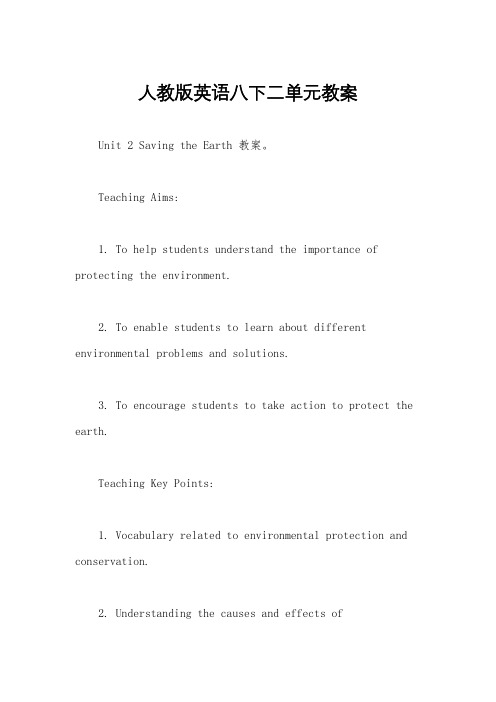
人教版英语八下二单元教案Unit 2 Saving the Earth 教案。
Teaching Aims:1. To help students understand the importance of protecting the environment.2. To enable students to learn about different environmental problems and solutions.3. To encourage students to take action to protect the earth.Teaching Key Points:1. Vocabulary related to environmental protection and conservation.2. Understanding the causes and effects ofenvironmental problems.3. Discussing and debating different solutions to environmental issues.4. Encouraging students to take action to protect the environment.Teaching Difficult Points:1. Encouraging students to think critically about environmental issues and potential solutions.2. Encouraging students to take action in their daily lives to protect the environment.Teaching Procedures:Step 1: Warm-up (10 minutes)。
部编人教版八年级英语下册教案:第二单元单元教学设计
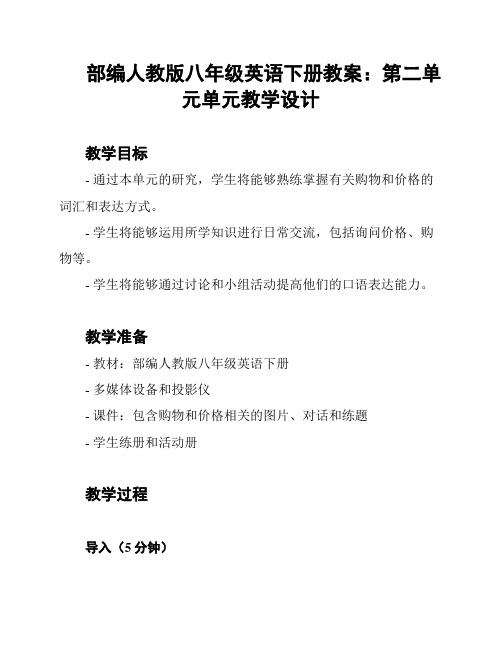
部编人教版八年级英语下册教案:第二单元单元教学设计教学目标- 通过本单元的研究,学生将能够熟练掌握有关购物和价格的词汇和表达方式。
- 学生将能够运用所学知识进行日常交流,包括询问价格、购物等。
- 学生将能够通过讨论和小组活动提高他们的口语表达能力。
教学准备- 教材:部编人教版八年级英语下册- 多媒体设备和投影仪- 课件:包含购物和价格相关的图片、对话和练题- 学生练册和活动册教学过程导入(5分钟)- 利用图片、视频或真实场景来引入话题,让学生了解购物和价格的相关概念。
新课讲解(15分钟)- 利用多媒体展示购物和价格的词汇和表达方式。
- 引导学生研究如何询问价格、购物等相关表达方式,并提供相关的口语练。
练活动(20分钟)- 分组讨论:学生们分成小组,讨论自己喜欢的商品和其价格,并彼此交流。
- 角色扮演:安排学生分成小组,进行购物场景的角色扮演,练口语表达和交流。
- 练题:利用课件或练册上的题,让学生们巩固所学知识。
拓展活动(15分钟)- 设计购物任务:学生们分成小组,根据老师提供的购物任务,规划购物行程,包括选择商品、比较价格等。
- 小组展示:每个小组向全班展示他们的购物任务和规划,分享自己的经验和策略。
总结(5分钟)- 老师对本节课进行总结,强调学生们所学到的购物和价格相关的知识和表达方式。
作业- 学生们需要完成相关的练题和课后作业,巩固所学知识。
- 布置下一节课的预任务。
教学评估- 教师观察学生的参与度和口语表达能力,进行实时评估。
- 批改学生们完成的练题和作业,给予针对性的反馈。
注意事项- 确保教学过程有足够的互动和实践机会,以提高学生的口语表达能力。
- 激发学生的兴趣,让他们主动参与到课堂活动中。
- 适当调整教学节奏,以满足学生们的研究需要和掌握程度。
以上是部编人教版八年级英语下册第二单元的教学设计。
请根据具体情况调整和完善,确保教学效果的达成。
八年级下册英语unit2教案
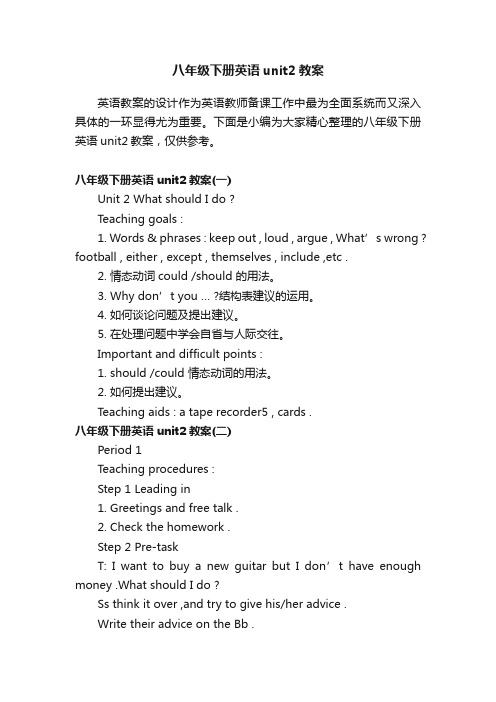
八年级下册英语unit2教案英语教案的设计作为英语教师备课工作中最为全面系统而又深入具体的一环显得尤为重要。
下面是小编为大家精心整理的八年级下册英语unit2教案,仅供参考。
八年级下册英语unit2教案(一)Unit 2 What should I do ?Teaching goals :1. Words & phrases : keep out , loud , argue , What’s wrong ? football , either , except , themselves , include ,etc .2. 情态动词could /should 的用法。
3. Why don’t you … ?结构表建议的运用。
4. 如何谈论问题及提出建议。
5. 在处理问题中学会自省与人际交往。
Important and difficult points :1. should /could 情态动词的用法。
2. 如何提出建议。
Teaching aids : a tape recorder5 , cards .八年级下册英语unit2教案(二)Period 1Teaching procedures :Step 1 Leading in1. Greetings and free talk .2. Check the homework .Step 2 Pre-taskT: I want to buy a new guitar but I don’t have enough money .What should I do ?Ss think it over ,and try to give his/her advice .Write their advice on the Bb .1. Borrow one .2. Buy a second-hand guitar .3. Get a part-time job .4. Don’t buy a guitar .5. Wait until next year .Practice reading the advice by the Ss .导入: In this unit we are going to talk about problems people have and learn how to give these people advice –to tell people what we think they should do .Step 3 While-taskSB Page 10 , 1a .1. Read the instructions to the Ss .2. Read the problems by the Ss .3. Ask Ss to write the problems in the “Serious” or “Not serious” columns .4. Explain .5. Talk about the answers with the class .Practice reading .SB Page 10 , 1b .Make sure the Ss understand what should they do .Play the tape twice .Ss circle the problems they hear .Play the tape a third time .Check the answers .Step 4 Post-taskSB Page 10 , 1c .Look at the problems in activity 1a and make conversations .Step 5 While-taskSB Page 11 , 2a .1. Read the instructions .Make sure the Ss understand what should they do .2. Point to the sentences below .3. Play the tape the first time .Ss only listen .Pay attention toPeter’s friend’s advice .4. Play the tape again .Ss circle “could” or “should” .5. Correct the answers .SB Page 11 , 2b .Read the instructions .Pay attention to Peter’s answers .Play the tape again .Check the answers .Step 7 Post-taskMake conversations with peter and his friend with the help of 2a & 2b .Step 8 Grammar FocusReview the grammar box .Ss say the questions and the responses .Explain the differences between could/should .Homework:1. Go over the words .2. My clothes are out of style ,what should I do ? Please give the advice .教学后记:八年级下册英语unit2教案(三)Period 2Teaching procedures :Step 1 Leading in1. Greeting and free talk .2. Check the homework .Collect the students’ advice .Write it down on the Bb .Step 2 Pre-task1. Review the differences between “could /should” .2. Learn the new words in Page 12 .Step 3 While-taskSB Page 12 , 3a .1. Read the instructions .2. Read the conversations by Ss or listen to the tape .Then write “good idea”“okay idea” or “bad idea” .3. Talk about the students’ answers .4. Make sure the students understand the dialogue.Practice readingStep 4 Post-taskSB Page 12 , 3b .1. Read the instructions .Point out the example conversation and ask two students to read it to the class .2. Use your head .Find some other ways to get money that aren’t in the book .3. Ask Ss to work with partner as they ask for and give advice .4. Pairwork .5. Act out the conversations to the class .Step 5 While-taskSB Page 12 , Part 4 .1. Read the instructions .Make sure the Ss understand what they should do .2. To students read the dialogue .3. Practice reading .4. Ask another pair to give their advice on another topic .5. Pairwork .Homework :将下列短语或句型译为汉语1. keep out2. out of style3. What’s wrong ?4. call sb up5. pay for6. ask for something7. summer camp 8. stay at home教学后记:。
- 1、下载文档前请自行甄别文档内容的完整性,平台不提供额外的编辑、内容补充、找答案等附加服务。
- 2、"仅部分预览"的文档,不可在线预览部分如存在完整性等问题,可反馈申请退款(可完整预览的文档不适用该条件!)。
- 3、如文档侵犯您的权益,请联系客服反馈,我们会尽快为您处理(人工客服工作时间:9:00-18:30)。
I’d like to work outside.
I’ll help clean the city park.
You could give out food at a food bank.
教学难点
学会提供帮助的基本句型
教学准备
多媒体课件
教学过程
个人再探索
Step 1Warming up
3. We could ___ ___ signs.
4. Let’s make some notices, too. Then I’ll ____ them ____ after school.
5. We could each ____ ___ 10 students and ask them to come.
e.g.I don’t feel lonely because I made new friends here.
我不觉得孤独因为我交了新朋友。
ed to曾经,过去
e.g.Jack used to be short, but now he’s tall.杰克过去很矮,但现在高了。
Step 3 Discussion
能掌握以下句型:
① Youcould help to clean up the city parks.
② We should listen to them and care for them.
2)能了解以下语法:
情态动词could, should的用法;用should或could提出建议并对别人的建议作出评价。如何表达主动提供帮助。
②Help clean up the city park.
③Visit the old people in the old people’s home.
④Help young kids to learn English.
Step 4Listening
1. T: Tell Ss to read the sentences in the chart. Make sure they know the meaning of thesentences.
4.volunteerv.义务劳动,自愿做volunteer to do sth.义务自愿做某事
e.g.Many people volunteer to work on the farm.很多人志愿到农场去工作。
5.clean up打扫;清除
e.g.The students take turns to clean up their classroom.学生们轮流打扫教室。
Answers: b, c, e
2.2b:
1. Let Ss read the sentences below. Explain some main sentences for the Ss. Make sure they know what to do.
2. Play the recording for the Ss to write the correct words in the blanks.
2. Let one pair to read out their conversation first.
e.g.
A: We need to come up with a plan for the City Park Clean-Up Day.
B: Let’s have lunch first.
A: No, we need to start now. Clean-Up Day is only two weeks from now.
____________________________________
Answers:She’s going to work in an old people’s home.
Reading the newspaper or just talking to the old people.
2. Read the conversation after the teacher.
2.noticen.公告牌;通告;布告
e.g.Please read the list on the notice board.请读公告板上的名单。
3.signn.标志;信号
e.g.Look around, we could see no sign of life.
环顾四围,我们看不出一点生命的迹象。
3.Practice the conversation with their partner. Then let some pairs to act out the conversation.
Step 9 Language points
1. They told me stories about the past and how things used to be.
1. Read the conversations and answer the two questions:
①Where’s Helen going to work this summer?
__________________________________
② What did Tom do to help the old people?
used to do sth.过去常常做某事;表示过去习惯性、经常性的动作或状态,暗指现在已经不存在。used无人称和时态的变化。
e.g. I used to go to theYouthCenter. But I have no time now.
B: You’re right. We can’t put off making a plan. As we talk, I’ll write down all our ideas. Then we can decide which ideas are best.
A: Let’s make some notices, too. Then I’ll hand them out after school.
2.情感态度价值观目标:
在授课过程中渗透助人就是助己,助人收获快乐的情感目标,使学生在谈论如何为别人提供帮助的对话中能意识到尽己所能,帮助他人,乐于奉献是一种良好的品德,培养学生为他人着想,热爱公益事业,乐于助人的优良品质。
教学重点
1)掌握这些短语动词的构成和用法:clean up, city, cheer, cheer up, give out, volunteer, notice, used to, lonely
A:I hope to work outside.
B:You could help to clean up the city parks.
……
3. Let some pairs act out their conversations.
Step6Listening
1.2a:
T:A group of students are planning aCityParkClean-up Day. Listen and check (√) the things they are going to do to tell people about it.
3. Play the recording again to check the answers.
Answers: 1. come up with 2. put off 3. put up 4. hand, out 5. call up
Step 7Pair work
1.2c.Tell Ss to make a conversation using the information in2aand 2b.
1. We need to _____ ___ ____ a plan to tell people about the city park clean- up.
2. Clean-up Day is only two weeks from now. We can’t ___ ___ making a plan.
1. Look at the pictures in2a. Discuss the things they are going to do.
2. Play the recording for the Ss to listen and check the pictures.
3. Play the recording again to check the answers.
___ The boy could give out food at the food bank.
___ The girl could volunteer in an after-school study program to teach kids.
___ The boy could help to clean up the city parks.
1.1a.Look at the ways you could help others. Then list other ways.
2. Ss discuss with their partners and write the ways one could help others:
①Help plant trees by the river.
6.give out分发;散发
e.g.Please help me give out these test papers.请帮我将这些试卷发下去。
7.cheerv.欢呼;喝彩
e.g.Cheer up. The news isn’t too bad.振作起来,消息还不算太坏。
8.lonelyadj.孤独的;寂寞的
